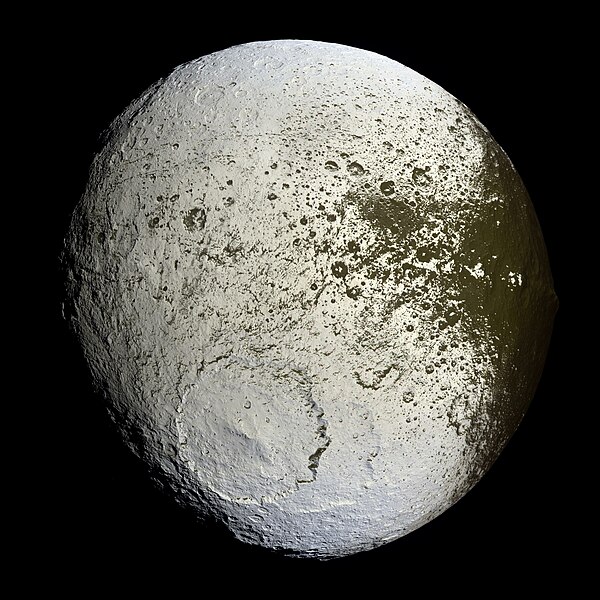चित्र:Iapetus as seen by the Cassini probe - 20071008.jpg

मूल फ़ाइल ((४,०३२ × ४,०३२ पिक्सेल, फ़ाइल का आकार: ६.२२ MB, MIME प्रकार: image/jpeg))
|

|
इस चित्र को विकिमीडिया कॉमन्स पर २७ दिसम्बर २००७ के लिए दैनिक प्रदर्शित चित्र के रूप में चुना गया था। इसका कैप्शन था: दूसरी भाषाएँ:
Magyar: A Iapetus, a Szaturnusz egyik holdja, a Cassini űrszonda felvételén hamis színezéssel (NASA/JPL/Space Science Institute) |

|
This image was selected as picture of the day on Vietnamese Wikipedia.
|
सारांश
| विवरणIapetus as seen by the Cassini probe - 20071008.jpg |
Iapetus as seen by the Cassini probe. |
| दिनांक | |
| स्रोत | PIA08384: The Other Side of Iapetus |
| लेखक | NASA / JPL / Space Science Institute |
| अनुमति (इस चित्र का पुनः उपयोग करना) |
PD |
This image or video was catalogued by Jet Propulsion Laboratory of the United States National Aeronautics and Space Administration (NASA) under Photo ID: PIA08384. This tag does not indicate the copyright status of the attached work. A normal copyright tag is still required. See Commons:Licensing. Other languages:
العربية ∙ беларуская (тарашкевіца) ∙ български ∙ català ∙ čeština ∙ dansk ∙ Deutsch ∙ English ∙ español ∙ فارسی ∙ français ∙ galego ∙ magyar ∙ հայերեն ∙ Bahasa Indonesia ∙ italiano ∙ 日本語 ∙ македонски ∙ മലയാളം ∙ Nederlands ∙ polski ∙ português ∙ русский ∙ sicilianu ∙ slovenščina ∙ Türkçe ∙ українська ∙ 简体中文 ∙ 繁體中文 ∙ +/− |
लाइसेंस
| Public domainPublic domainfalsefalse |
| This file is in the public domain in the United States because it was solely created by NASA. NASA copyright policy states that "NASA material is not protected by copyright unless noted". (See Template:PD-USGov, NASA copyright policy page or JPL Image Use Policy.) |  | |
 |
Warnings:
|
Captions
Items portrayed in this file
चित्रण
Commons quality assessment अंग्रेज़ी
Wikimedia Commons featured picture अंग्रेज़ी
८ अक्टूबर 2007
media type अंग्रेज़ी
image/jpeg
फ़ाइल का इतिहास
फ़ाइलका पुराना अवतरण देखने के लिये दिनांक/समय पर क्लिक करें।
| दिनांक/समय | अंगूठाकार प्रारूप | आकार | प्रयोक्ता | प्रतिक्रिया | |
|---|---|---|---|---|---|
| वर्तमान | १८:०७, १२ दिसम्बर २०१८ |  | ४,०३२ × ४,०३२ (६.२२ MB) | wikimediacommons>Kesäperuna | 100% JPEG quality from full quality TIFF, slightly cropped to be more centered. |
फ़ाइल का उपयोग
निम्नलिखित पन्ने इस चित्र से जुडते हैं :
